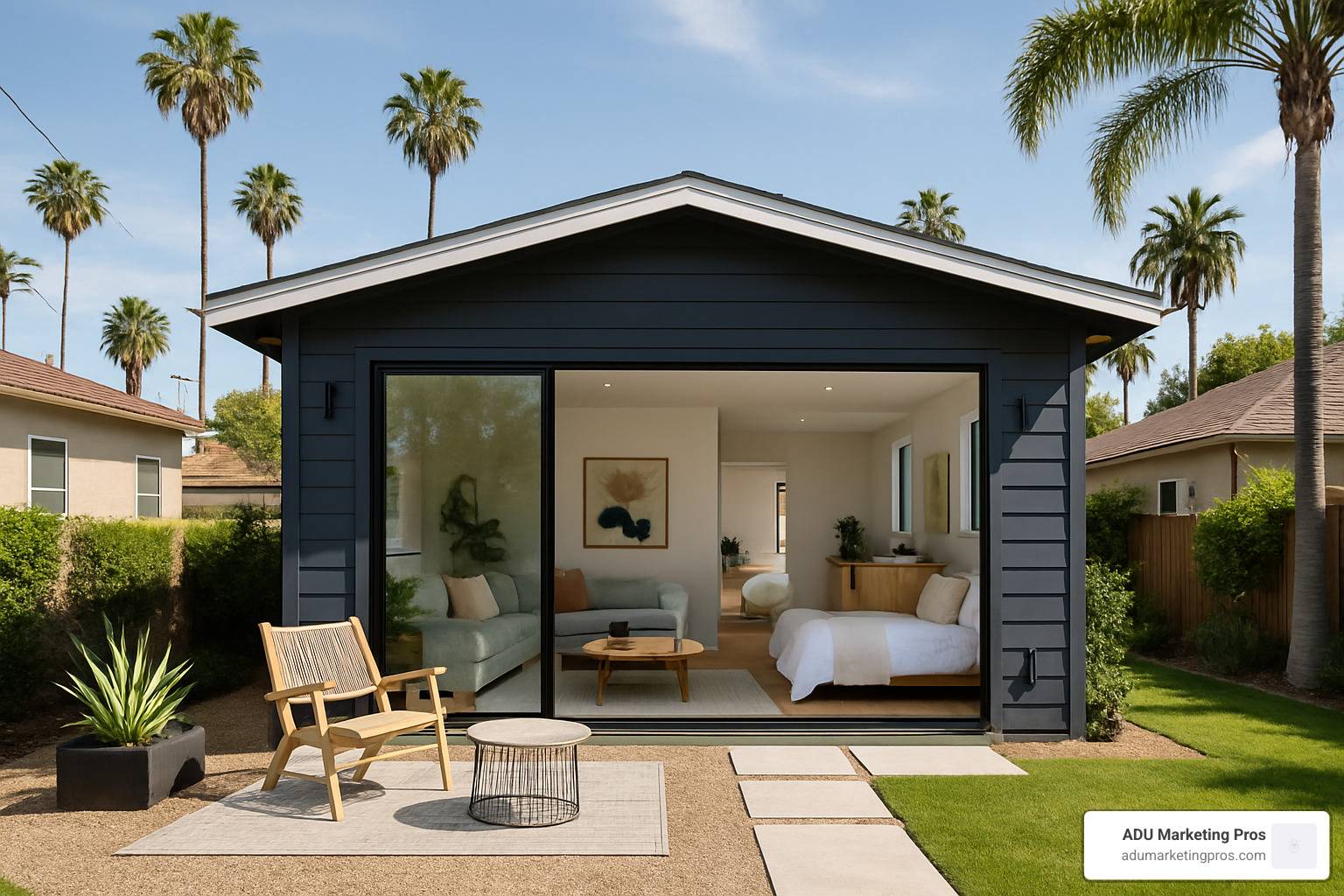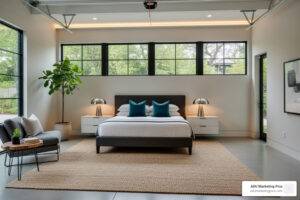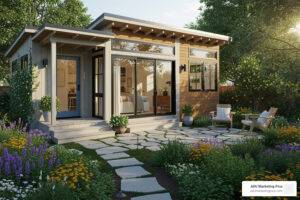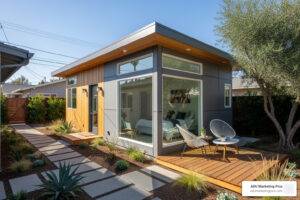The LA Garage Revolution: From Storage to Dream ADU
Garage conversion Los Angeles projects are changing underused spaces into valuable living areas across the city. Here’s what you need to know:
- Legal Status: Fully legal under California state law since 2017 (SB 1069)
- Average Cost: $100,000-$150,000 ($250-$350 per square foot)
- Timeline: Typically 6-9 months from planning to completion
- Permits Required: Building, electrical, plumbing, and mechanical permits through LADBS
- Popular Uses: Rental units, home offices, guest suites, multigenerational living spaces
With housing prices soaring and space at a premium, Los Angeles homeowners are finding gold mines sitting right in their driveways. That neglected garage collecting dust and forgotten holiday decorations? It could be your next income-generating ADU (Accessory Dwelling Unit), home office sanctuary, or solution for housing extended family.
Since January 2017, California state law has empowered any homeowner with a single-family residence in a residential zone to convert their garage into a livable, rentable dwelling unit. No longer just a trend, garage conversions have become a practical response to LA’s housing shortage while offering homeowners a chance to maximize their property’s potential.
“A garage conversion in Los Angeles is an incredibly popular home improvement project,” notes industry experts, and for good reason. These changes typically cost less than building new structures from scratch, can be completed in a matter of months, and often add more value to your property than the conversion costs.
Whether you’re looking to generate rental income (many units fetch $1,500-$2,500 monthly), create space for aging parents, or carve out a productive work-from-home environment, a garage conversion might be your most accessible entry point into ADU ownership.
In this guide, we’ll walk you through everything you need to know about converting your Los Angeles garage into a functional, beautiful living space—from navigating permits and understanding costs to maximizing your return on investment.
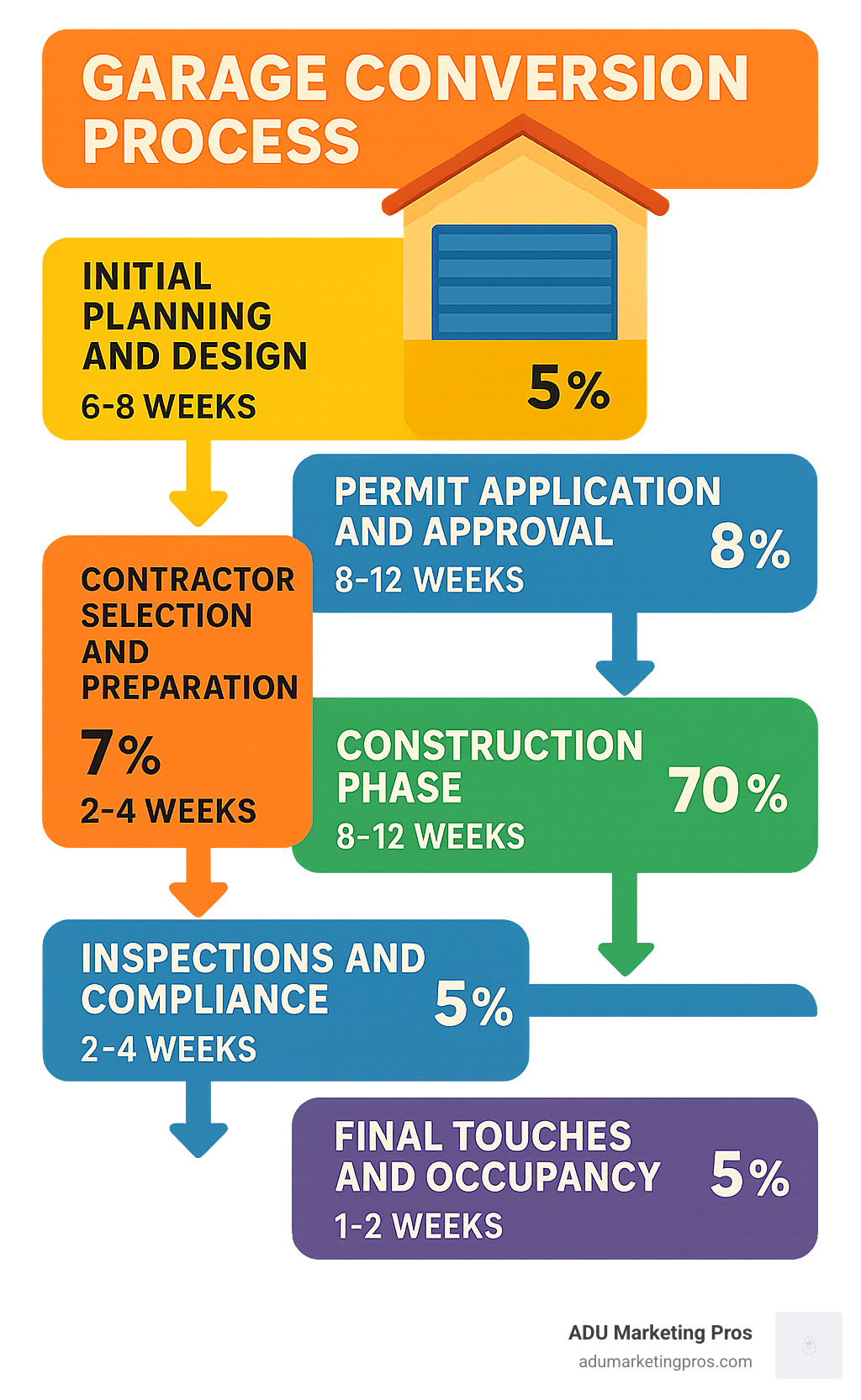
Garage conversion Los Angeles terms explained:
– ADU cost Bay Area
– ADU marketing strategies
– ADU modular homes
Garage Conversion Los Angeles: Laws, Definitions & 2025 Updates
The legal landscape for garage conversion Los Angeles projects has evolved dramatically in recent years, opening doors for homeowners to transform underused spaces into valuable living areas. Before you start dreaming about knocking down walls, though, let’s get clear on what exactly makes a converted garage an ADU, and how today’s regulations will shape your project.
Since January 2017, when Senate Bill-1069 came into effect, California has been rolling out the welcome mat for ADUs on single-family properties. This groundbreaking legislation swept away many of the roadblocks that previously made garage conversions feel like mission impossible.
Under Los Angeles Municipal Code, an Accessory Dwelling Unit isn’t just any converted space—it’s specifically a secondary dwelling unit that provides complete independent living facilities on the same lot as your main home. Think of it as a mini-home with all the essentials: living space, sleeping area, kitchen, and bathroom.
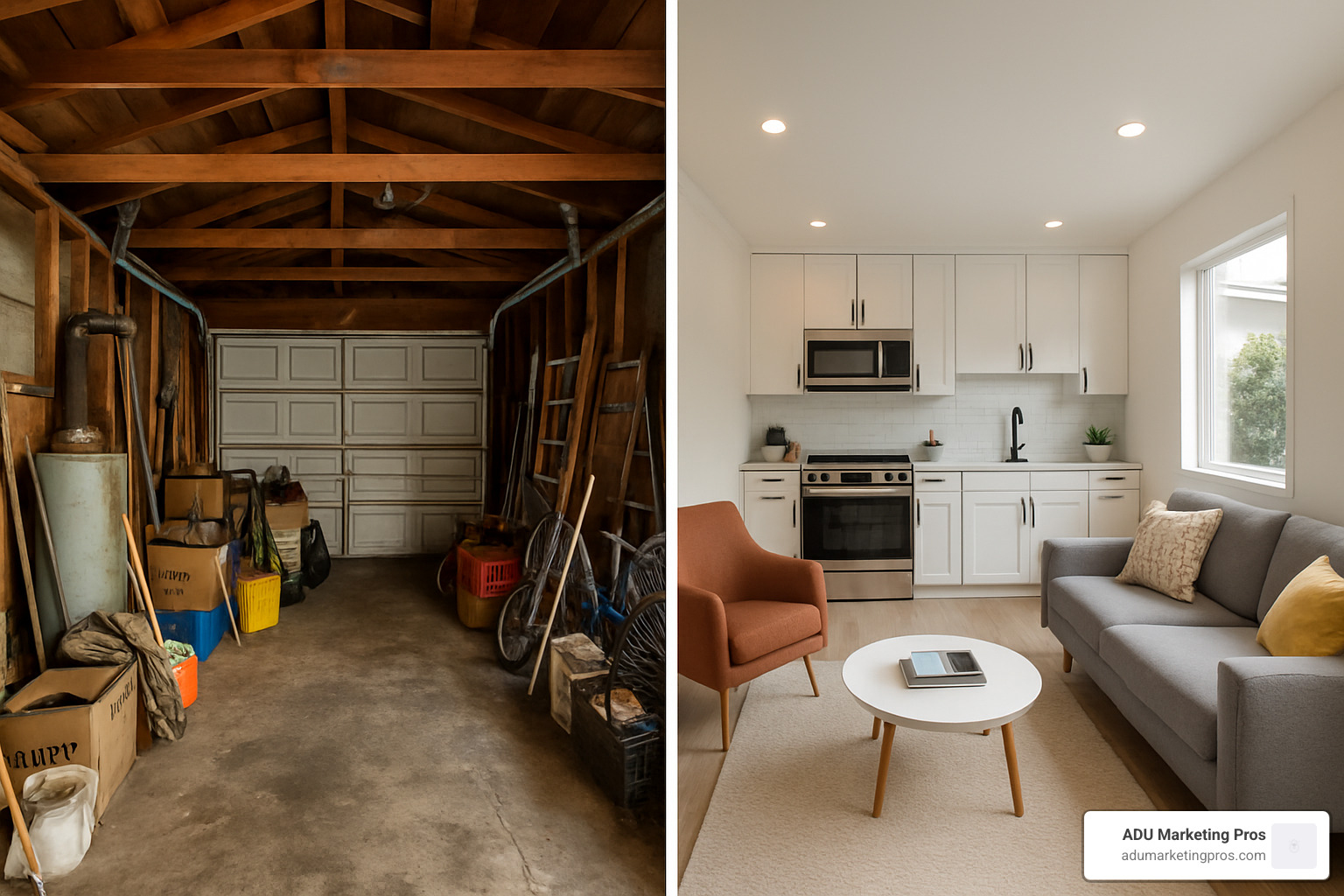
Garage vs ADU: Know the Legal Lines
Not all garage makeovers qualify as ADUs, and the distinction matters more than you might think:
When you convert your garage into a home gym or office without adding a kitchen, that’s just a regular conversion—not technically an ADU in the eyes of Los Angeles regulations. To cross into ADU territory, your converted garage needs a proper kitchen (sink, stove, refrigerator), bathroom facilities, and designated living and sleeping areas.
Then there’s the JADU (Junior ADU) option—the ADU’s smaller cousin, maxing out at 500 square feet. These can be created within your existing home’s walls, including that attached garage. Some JADUs even share certain facilities with the main house, making them a bit more integrated.
These distinctions matter for several practical reasons. For ADUs created before January 1, 2025, cities may require you (the property owner) to live in either the main house or the ADU. However, this requirement is on pause for ADUs permitted between January 2020 and January 2025—giving investors a temporary opportunity.
It’s also worth noting that your ADU can’t be sold separately from your main house—they’re a package deal. And while ADUs must comply with zoning regulations, garage conversion Los Angeles projects face fewer restrictions than building something new from scratch.
One of the biggest perks of garage conversions? You typically don’t have to worry about setback requirements if you’re keeping the existing structure’s footprint. This is a significant advantage over detached ADUs, which require at least 5 feet of side and rear setback.
Is a Garage Conversion Los Angeles Project Right for Me?
Before you dive headfirst into a garage conversion Los Angeles project, take a moment to consider these key factors:
Parking reality check: Converting your garage means saying goodbye to covered parking. While state law doesn’t require replacement parking for garage conversion ADUs, think about how this might affect your daily routine and property value down the road.
Space assessment: Take a good look at your property’s layout. Will there be comfortable access to the unit? How will the conversion impact your outdoor living areas? That beautiful backyard might feel a bit smaller once your garage becomes living space.
Goal clarity: Be honest about what you’re trying to achieve. A unit designed primarily for rental income might look very different from one created for aging parents or your own home office. Your goals should drive your design decisions and budget priorities.
Future planning: Consider your long-term plans for the property. If you’re looking at this as a five-year investment versus a forever home, your approach might differ significantly.
Structural reality: Have a professional take a good look at your garage’s bones. Some older Los Angeles garages might need significant structural upgrades to meet residential codes, which could impact your budget considerably.
New 2025 ADU Laws: What SB 1211, AB 2533 & SB 1077 Mean for You
Several exciting new laws taking effect in 2025 will expand ADU possibilities even further in Los Angeles:
SB 1211 is truly game-changing for multi-family properties. This legislation will allow up to eight ADUs on multi-family properties, dramatically expanding the potential for garage conversions in apartment and condo settings. It also eases parking requirements and streamlines the approval process—a win-win for property owners.
For homeowners with existing unpermitted garage conversions, AB 2533 offers a path to legitimacy. This law provides a way to legalize unpermitted ADUs built before January 1, 2020, without certain impact fees. If you’ve been living with an unauthorized conversion, this could be your chance to bring your property into compliance without breaking the bank.
Living near the coast? SB 1077 addresses ADU development in coastal zones, making it easier to convert garages in these previously restricted areas by limiting the grounds on which a coastal development permit can be denied. This opens up conversion opportunities in some of LA’s most desirable neighborhoods.
These new laws reflect California’s serious commitment to addressing the housing crisis by helping homeowners maximize their existing structures. For garage conversion Los Angeles projects planned for 2025 and beyond, these regulations offer even more flexibility and opportunity to create valuable living space.
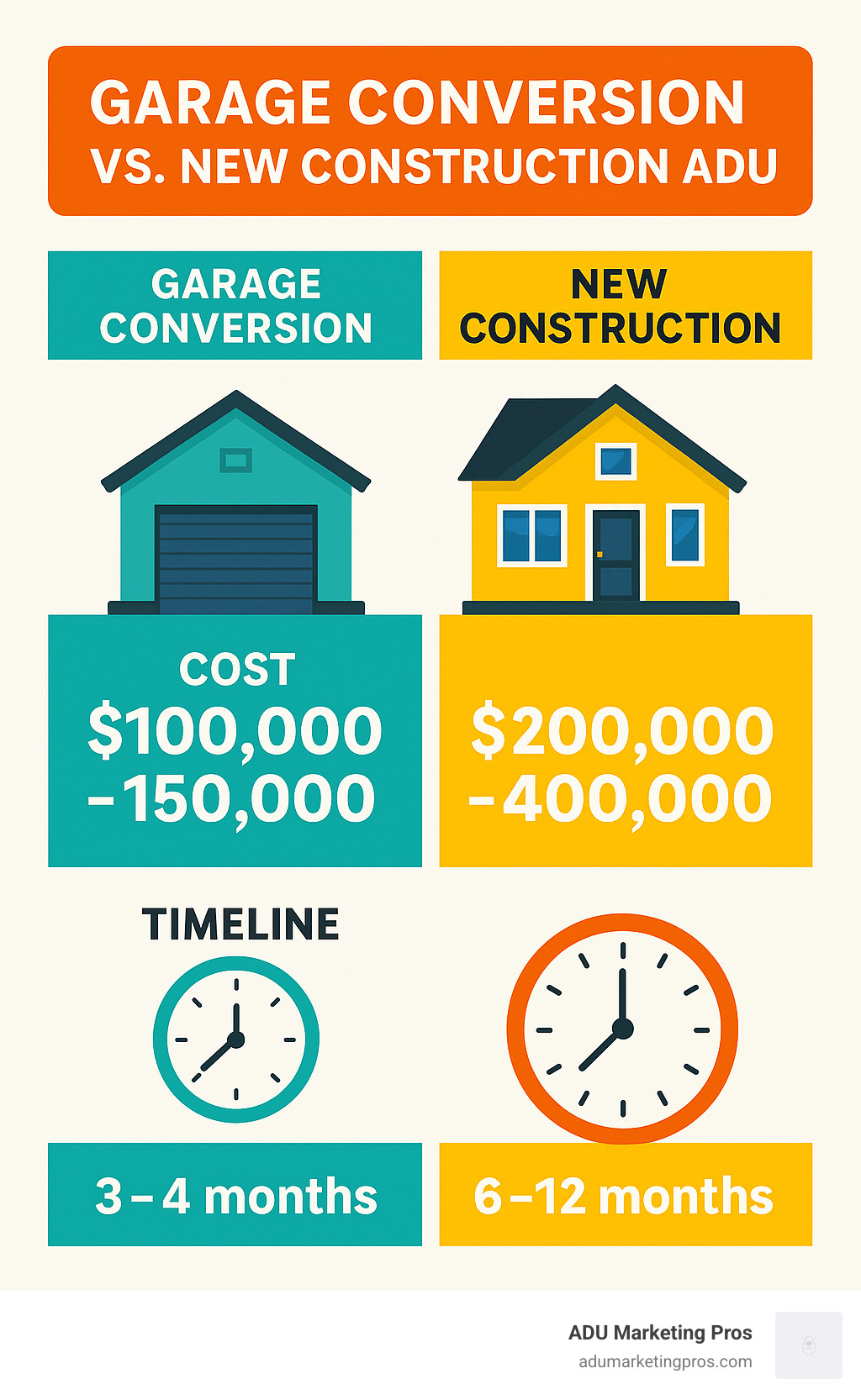
Want to dive deeper into Los Angeles ADU regulations? Check out our comprehensive guide to Los Angeles ADU Regulations for everything you need to know before starting your project.
Budget, Costs & ROI Strategies
When planning your garage conversion Los Angeles project, understanding the financial side is essential for success. Let’s break down what you can expect to invest and the returns you might see.
Most garage conversions in Los Angeles typically cost between $100,000 and $150,000 all-in. This translates to about $250-$350 per square foot, depending on your choices for finishes, any structural needs, and utility connections. While that might sound substantial, converting an existing garage is generally more affordable than building a brand-new ADU from scratch—you’re already starting with a foundation and basic structure.
Breaking Down the Budget Line-by-Line
Your garage conversion Los Angeles budget will be distributed across several key areas. Understanding where your money goes helps you make informed decisions about where to splurge and where to save.
The design phase typically consumes 5-10% of your budget, covering architectural drawings, structural engineering, and those all-important Title 24 energy calculations that California requires. Think of this as the blueprint investment that prevents costly mistakes down the road.
The next 5-8% goes toward demolition and site prep—removing that old garage door, clearing out the interior, and addressing any hazardous materials lurking in older structures.
Your foundation and structural work will take a bigger bite, around 10-20% of the budget. This includes any necessary foundation upgrades and framing for your new walls, ceiling, and floor. Many older garages weren’t built to residential standards, so this is an area where surprises can lurk.
One of the most significant expenses often comes from trenching and utility connections, consuming 10-15% of your budget. This includes connecting to sewer lines, installing water service, and potentially upgrading your electrical panel to handle the additional demand.
Your MEP systems (mechanical, electrical, plumbing) will take another 15-20%, covering everything from outlet placement to shower drains. For HVAC, most homeowners opt for energy-efficient mini-split systems that don’t require extensive ductwork.
The remaining budget gets divided among insulation and drywall (5-10%), flooring and finishes (15-20%), bathroom and kitchen installations (15-25%), exterior work to match your home (5-10%), and those unavoidable permits and inspections (5-8%).
Financing & Grants for Your ADU
The good news is you don’t need to have all the cash upfront for your garage conversion Los Angeles project. Several smart financing options exist:
A Home Equity Line of Credit (HELOC) offers flexibility, allowing you to borrow against your home’s equity with the ability to draw funds as needed during construction. Many homeowners appreciate the flexibility of only paying interest on what you’ve actually used during the renovation phase.
If you prefer a single loan, a cash-out refinance replaces your existing mortgage with a larger one, giving you the difference to fund your conversion. This option often makes sense when you can also secure a lower interest rate than your current mortgage.
For those who qualify, the CalHFA ADU Grant Program is practically free money—offering up to $40,000 for eligible homeowners. As of December 2023, families earning $84,160 or below in Los Angeles County can apply. This program was specifically designed to help address California’s housing shortage while giving homeowners financial assistance.
Some specialized lenders now offer ADU-specific financing products that understand the unique nature of these projects better than traditional banks. These often come with more flexible terms custom to the ADU construction timeline.
Whatever financing route you choose, be sure to factor the monthly payments into your overall budget, especially if rental income is part of your plan.
Maximizing ROI in a Tight Market
A well-executed garage conversion Los Angeles project can significantly boost both your property’s value and your monthly income. In many Los Angeles neighborhoods, ADUs command $1,500-$2,500 in monthly rent—making the financial case quite compelling.
To maximize your return on investment, start by researching comparable rentals in your specific neighborhood. What amenities do they offer? What’s the going rate? This research helps you design a space that meets market demands.
Focus your design dollars on features renters value most: private entrances that offer independence, abundant natural light, smart space-efficient layouts, and quality finishes in kitchens and bathrooms. These elements consistently command premium rents.
Think long-term about flexibility. Today’s rental might become tomorrow’s home office or a suite for aging parents. Designing with adaptability in mind extends the useful life of your investment.
Energy efficiency isn’t just environmentally responsible—it’s financially smart. Proper insulation, energy-efficient windows, and right-sized HVAC systems reduce operating costs while appealing to environmentally conscious renters who appreciate lower utility bills.
Once completed, consider getting a new appraisal that specifically accounts for the added square footage and rental income potential. Many homeowners are surprised by how significantly their property value increases after a quality conversion.
The ROI math is compelling: A $150,000 investment generating $2,000 monthly ($24,000 annually) provides a cash-on-cash return of 16% before expenses—substantially outperforming most traditional investments. Even after accounting for taxes, insurance, and maintenance, many Los Angeles homeowners see returns that make their garage conversion one of their smartest financial moves.
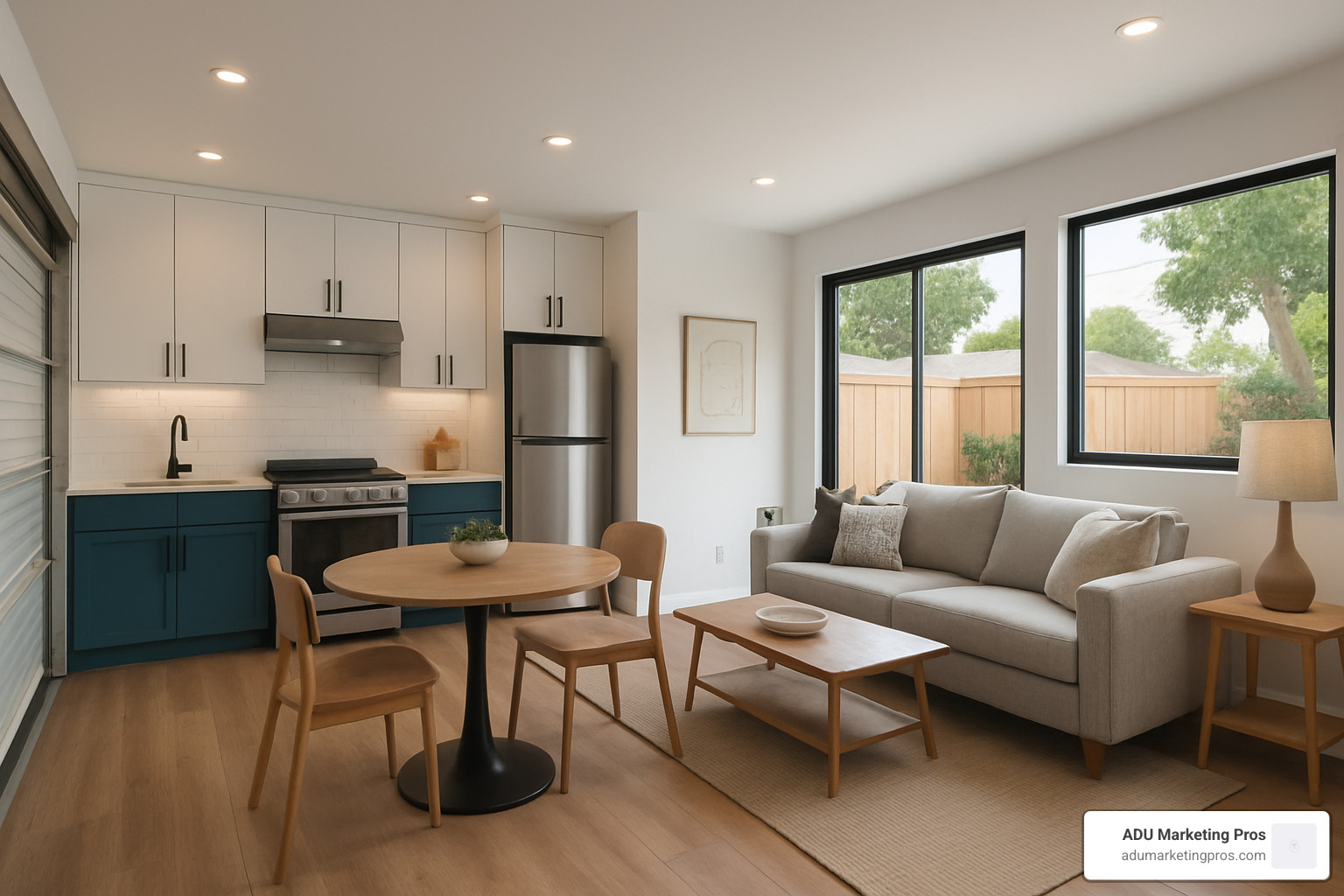
Permit-to-Keys Timeline & Design Best Practices
Let’s face it—the permitting process can feel like navigating a maze when tackling your garage conversion Los Angeles project. But don’t worry! Understanding what lies ahead will help you avoid those frustrating (and costly) delays.
Most garage-to-ADU journeys take about 6-9 months from that first sketch to the moment you’re holding the keys. Here’s how that timeline typically breaks down:
- Planning and design work usually takes 6 weeks to 3 months (depending on how decisive you are about layouts and finishes!)
- Permit applications and approvals can stretch 2-4 months (the infamous “hurry up and wait” phase)
- Actual construction moves relatively quickly at 2-3 months
- Final inspections and getting that precious Certificate of Occupancy takes 2-4 weeks
Los Angeles uses the EPIC-LA portal for online permit submissions, which can make things smoother—though “smooth” is relative when dealing with city bureaucracy! All plans need to comply with Title 24 energy efficiency standards, covering everything from how you insulate the walls to the type of windows and lighting you install.
Permitting Path: From EPIC-LA to Certificate of Occupancy
Your garage conversion Los Angeles permitting journey follows a pretty clear path, even if it sometimes feels like you’re taking the scenic route:
Start with a pre-design consultation with LADBS (Los Angeles Department of Building and Safety). This small investment of time can save you thousands by identifying potential issues before you’re knee-deep in architectural plans.
Next comes plan development with your architect or designer. For garage conversions, you’ll need detailed drawings showing the garage location, floor plans, electrical layouts, plumbing details, HVAC systems, and structural modifications. Think of this as the blueprint for your dream space—worth getting right!
When you’re ready to submit, upload everything to the EPIC-LA portal or brave an in-person visit to your local LADBS office. Be prepared to pay fees based on your project’s value (the city never misses a chance to collect, right?).
Your plans will then make the rounds to various agencies—City Planning for zoning, Bureau of Engineering for right-of-way issues, Transportation for driveway access, and DWP for utilities. This is where patience becomes your best friend.
Almost everyone faces at least one round of corrections. Address these promptly to keep things moving—every day of delay is a day without rental income or use of your new space.
Once approved, you’ll pay the remaining fees and collect your building permit, along with separate permits for electrical, plumbing, and mechanical work. Now the fun begins!
During construction, you’ll need inspections at key milestones: foundation work, framing, rough electrical/plumbing/mechanical, insulation, drywall, and the final inspection. Schedule these promptly to maintain momentum.
The grand finale? Your Certificate of Occupancy—the official document that transforms your former car storage into legal living space.
Smart Design Moves for Small Footprints
Creating a functional, beautiful space in a converted garage requires some clever thinking. After all, most Los Angeles garages weren’t designed with human comfort in mind!
Open layouts are your friend in small spaces. Consider minimizing interior walls to create a sense of spaciousness. Many successful garage conversion Los Angeles projects use partial walls or built-in furniture as room dividers instead of full walls.
Multi-purpose spaces maximize functionality. Think sofa beds, dining tables that double as workspaces, or Murphy beds that transform a living room into a bedroom at night. In tight quarters, every square foot needs to pull double duty.
Natural light transforms a space from cave-like to cozy. Replace that garage door with large windows or glass doors to flood the space with sunshine. If your budget allows, skylights can work wonders in bringing light into the center of the unit.
Ceiling height strategies matter in former garages, which often have lower ceilings than ideal. Where possible, raise the ceiling or use exposed beams to create visual height. Where that’s not possible, recessed lighting avoids fixtures that hang down and make the space feel cramped.
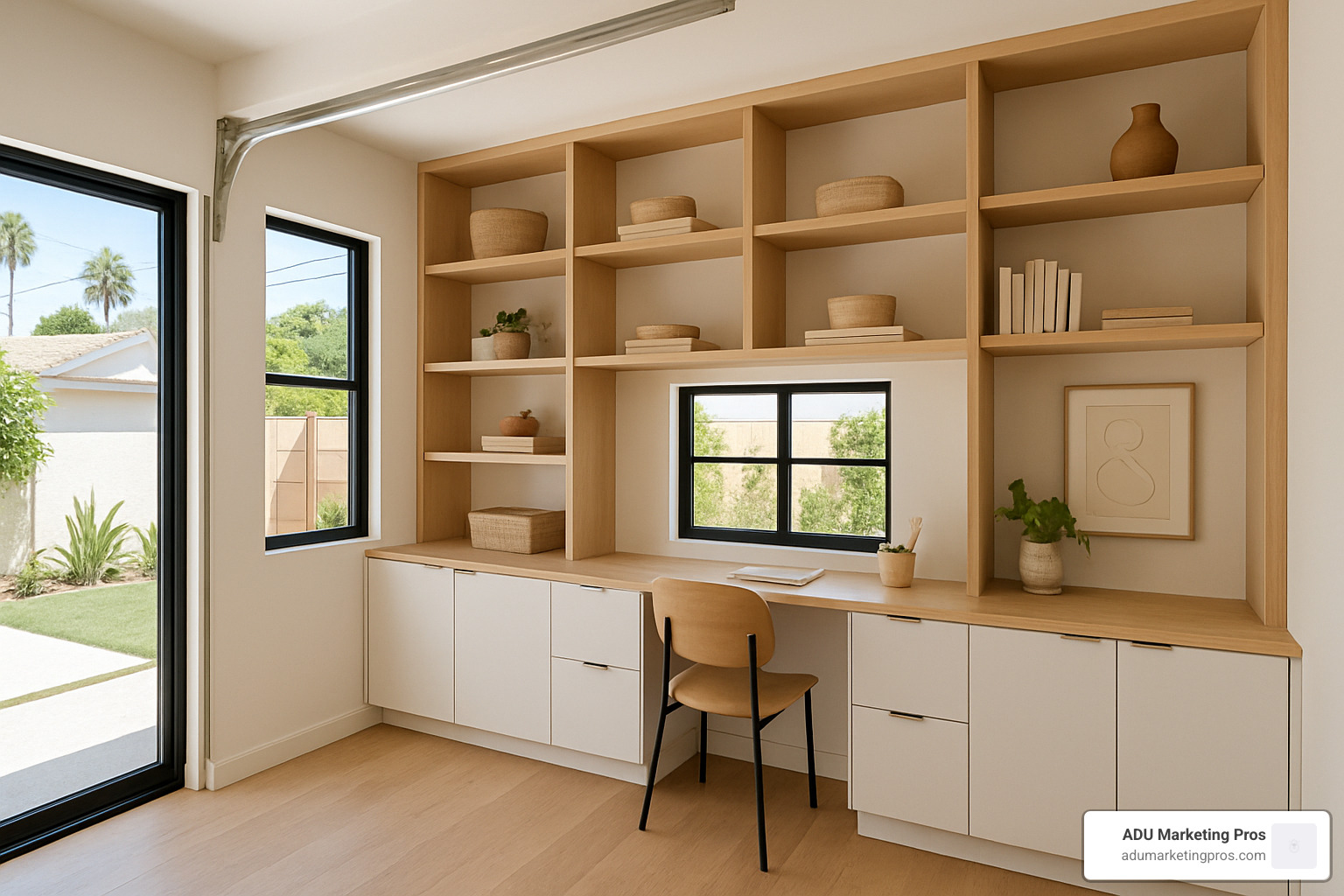
Smart storage solutions are essential—built-in cabinets under stairs, wall niches, and furniture with hidden storage compartments can help keep the space from feeling cluttered. The beautiful built-in wall shown above combines workspace and storage in one neat solution.
Kitchen efficiency doesn’t mean sacrificing function. Compact kitchens with appropriately sized appliances—refrigerator drawers, two-burner cooktops, or combination microwave/convection ovens—save space while still allowing for proper meal preparation.
Bathroom space-savers like corner sinks, pocket doors, and shower stalls rather than tubs help maximize functionality. A well-designed 5×8 bathroom can feel surprisingly spacious with the right fixtures.
Flooring choices matter both aesthetically and practically. Luxury Vinyl Plank (LVP) has become the darling of garage conversion Los Angeles projects, offering durability, water resistance, and affordability at $3-$5 per square foot. Plus, it’s warmer underfoot than the concrete that was there before!
HVAC solutions for garage conversions typically center around mini-split systems, which provide efficient heating and cooling without extensive ductwork. They’re quiet, energy-efficient, and can be installed without major structural modifications.
Sound insulation isn’t just a nice-to-have, especially if you’re creating a rental unit. Investing in proper sound insulation between walls and in the ceiling ensures privacy for both the ADU occupants and the main house residents.
Choosing & Managing Contractors
Finding the right contractor can make or break your garage conversion Los Angeles project. Here’s how to make sure you’re in good hands:
Always verify credentials before signing anything. Your contractor should be properly licensed, bonded, and insured—check their license status through the Contractors State License Board. This simple step can save you from a world of headaches down the road.
Look for specialists, not generalists. Contractors with specific experience in garage conversions or ADUs will anticipate common challenges and know the regulatory requirements inside and out. They’ve likely solved the exact problems your project will face.
Don’t just take their word for it—ask for references from previous garage conversion projects and actually call them! If possible, visit completed projects to see the quality firsthand. A good contractor will be proud to show off their work.
Your contract should be crystal clear, including a fixed price rather than time-and-materials when possible, detailed scope of work, payment schedule tied to completion milestones, clear timeline, change order process, and warranty information. Vague contracts lead to disputes and cost overruns.
Establish a change order management process from the start. Even the best-planned projects encounter surprises when you open up walls, and having a clear process for handling these unexpected issues prevents misunderstandings.
Set expectations for regular communication. Will you get weekly updates? Who’s your main point of contact? How quickly can you expect responses to questions? A contractor who communicates well is worth their weight in gold.
Before making that final payment, create a detailed punch list of any remaining items that need completion or correction. Don’t be shy about pointing out imperfections—this is your space and you deserve to have it finished properly.
By navigating both the permitting maze and construction phase with care, your garage conversion Los Angeles project can proceed relatively smoothly, resulting in a beautiful, functional living space that meets all legal requirements—and maybe even exceeds your expectations.
Frequently Asked Questions about Garage conversion Los Angeles
Curious about changing your garage into livable space? You’re not alone. Here are the answers to the questions we hear most often about garage conversion Los Angeles projects.
What permits are required for a Garage conversion Los Angeles?
Converting your garage requires navigating several permits through the Los Angeles Department of Building and Safety (LADBS). Don’t worry—while the paperwork might seem daunting, thousands of homeowners successfully complete this process each year.
You’ll need a building permit for the overall structural work, an electrical permit for all new wiring and fixtures, a plumbing permit for bathroom and kitchen installations, and a mechanical permit for your HVAC system.
The most important thing to understand is that you’re seeking a “change of use” approval, since you’re changing a non-habitable space into a living area. This means your plans must demonstrate compliance with residential requirements for ceiling height, ventilation, emergency exits, and insulation.
Your plans must also meet Title 24 energy efficiency standards—California’s way of ensuring your new living space won’t waste energy or inflate your utility bills. While this adds some complexity to your project, these standards ultimately create a more comfortable, efficient living space.
How long does the whole process take?
From initial sketches to handing over the keys, expect your garage conversion Los Angeles journey to take about 6-9 months. Here’s how that timeline typically breaks down:
The design phase usually takes 2-3 months for creating architectural plans, engineering work, and energy calculations. The permitting phase often requires 2-4 months for submission, plan check, corrections, and finally receiving those precious permits. Once approved, the construction phase typically spans 2-3 months, followed by final inspections taking 2-4 weeks to obtain your Certificate of Occupancy.
Real talk: we recommend building in a 2-3 month buffer. Even the smoothest projects can face unexpected problems like contractor scheduling conflicts, material delays, or additional rounds of plan corrections. The permitting phase is particularly unpredictable, so patience serves you well here.
Many homeowners find the waiting challenging, but remember—this temporary process creates a permanent asset that will serve you for decades to come.
Can I legalize an existing unpermitted conversion?
Yes, you absolutely can bring an unpermitted garage conversion Los Angeles project into compliance, and recent legislation has made this somewhat easier.
The upcoming AB 2533 (effective 2025) offers a pathway to legalize unpermitted ADUs built before January 1, 2020, without certain impact fees. This can represent significant savings, but the process still requires careful navigation.
You’ll need to create “as-built” plans showing your conversion’s current configuration. A building inspector will then evaluate your space against current codes—not the codes that existed when the conversion was done. This often means making updates to meet today’s safety and energy standards.
Common issues that need addressing include insufficient ceiling height, inadequate insulation, improper electrical wiring, missing egress windows, non-compliant plumbing, and absent smoke and carbon monoxide detectors. You’ll pay current permit fees, and in some cases, there may be penalties for the unpermitted work.
While legalizing can sometimes be more complex than starting fresh (since you’re working backward to meet codes), the benefits make it worthwhile: peace of mind about safety, proper insurance coverage, and legal protection when eventually selling your property.
If you’re uncertain about an existing conversion’s status, consult with an architect or contractor experienced in ADU legalization before approaching the building department. They can help you understand what you’re facing and develop a strategic plan for compliance.

Conclusion
Changing your garage into a functional living space represents one of the most accessible and valuable home improvement projects available to Los Angeles homeowners today. With housing at a premium and new laws continuously expanding opportunities, a garage conversion Los Angeles project offers a unique combination of benefits:
-
Financial Returns: Whether through rental income or increased property value, garage conversions typically pay for themselves over time.
-
Space Maximization: Convert underused storage into productive living space without expanding your home’s footprint.
-
Housing Solutions: Create independent living quarters for family members, rental income, or work-from-home space.
-
Legal Simplicity: Compared to new construction, garage conversions face fewer regulatory problems and setback requirements.
As we’ve explored throughout this guide, the keys to a successful conversion include thorough planning, understanding the legal requirements, budgeting realistically, and working with qualified professionals. While the process requires patience—particularly during the permitting phase—the end result can transform both your property and your financial outlook.
The recent and upcoming legislative changes, including SB 1211, AB 2533, and SB 1077, further demonstrate California’s commitment to expanding ADU opportunities. These laws will make it even easier to convert garages into living spaces, legalize existing conversions, and maximize the potential of multi-family properties.
If you’re ready to explore a garage conversion for your Los Angeles property, we recommend starting with a feasibility assessment from a qualified architect or contractor who specializes in ADUs. This initial consultation can help you understand the specific opportunities and challenges of your property before making a significant investment.
At ADU Marketing Pros, we work with the best ADU specialists across Los Angeles to help homeowners steer this exciting opportunity. While we don’t build ADUs ourselves, our expertise in the ADU market allows us to connect homeowners with trusted professionals who can bring your vision to life.
Ready to transform your garage into a dream ADU? Learn more about ADU marketing strategies and how we can help you connect with the right professionals for your project.

